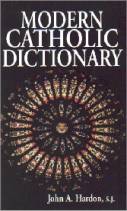|
The need for a modern Catholic dictionary seems obvious. Much has happened in the Catholic Church since the opening of the Second Vatican Council in 1962. The council itself was a historic event whose sixteen documents, confirmed by Pope Paul VI, have deeply influenced the thinking of all the faithful. As a result new words and expressions have entered the Catholic vocabulary and old terms have taken on a fresh and more profound meaning. Moreover, the world in which the faithful live has undergone major changes, some would say among the most profound in Christianity since the apostolic age. Marxism is a stark reality. Secularism is no longer a mere theory; it is the chosen way of life of large segments of Western society. Marriage and the family are on trial for their existence; abortion and now euthanasia are being legalized in one country after another. This has placed a grave strain on Catholicism, and the effects are showing across a wide spectrum of thought and practice, again with corresponding impact on the language of people who "instead of the spirit of the world," as St. Paul says, "have received the Spirit that comes from God." No dictionary is ever complete, and the present one makes no claim to comprehensiveness. There are too many terms in what may be called the Catholic vocabulary to even cover them all, let alone give an extensive treatment of each one. This is plainly meant to be a dictionary and not an encyclopedia. Yet, unlike other lexicons, a Catholic dictionary should be more than a mere listing of definitions. It cannot, in the name of objectivity, remain neutral on those things to which the Catholic Church has an established position. Otherwise, it would not merit being called Catholic. Wherever feasible exact Scripture references or even citations have been given, to enable the reader to go back to the Bible to see the defined term in its full biblical context. So, too, precise references, often with quotations, are given for the Church's doctrines, which may then be traced to their original sources, mainly in papal documents or the canons and decrees of ecumenical councils. Equivalent terms have not been multiplied beyond measure, but enough of them are available to help the reader find what is sought, perhaps defined under a heading different from the one that first comes to mind. Special attention was given to Catholic shrines and prayers. |
|
What's New Site Index
Adorers Society | PEA Manual | Essentials of Faith | Dictionary | Thesaurus | Catalog | Newsletters
718 Liberty Lane
Lombard, IL 60148
Phone: 815-254-4420
Contact Us
Website: www.therealpresence.org
Copyright © 2000 by www.therealpresence.org
All rights reserved worldwide.
No part of this publication may be reproduced, stored in a retrieval
system, or transmitted, in any form or by any means, electronic,
mechanical, photocopying, recording or otherwise, without the prior
written permission of www.therealpresence.org
 MODERN CATHOLIC DICTIONARY
MODERN CATHOLIC DICTIONARY